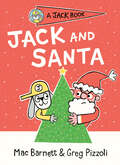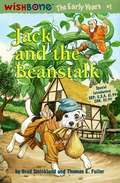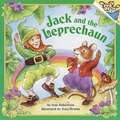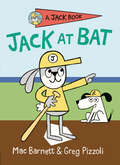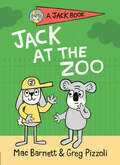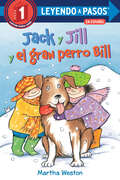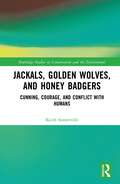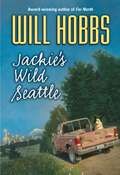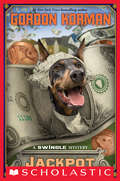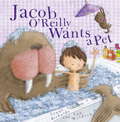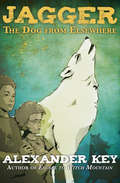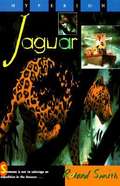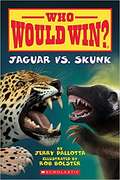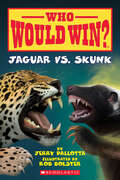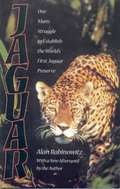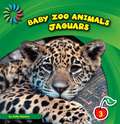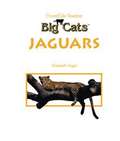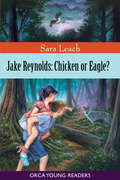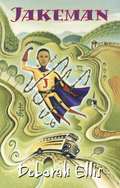- Table View
- List View
Jack and Santa (A Jack Book #7)
by Mac BarnettFrom New York Times bestselling author Mac Barnett and Geisel Award-winning illustrator Greg Pizzoli, an uproarious early reader series about a mischievous rabbit, a cranky old lady, and a lovable dog.When Jack finds himself on the naughty list, he worries that Santa will bring him coal. But Jack wants presents--lots of them. Will Jack be able to prove to Santa that he's not so bad after all?Welcome to the laugh-out-loud and irreverent world of Jack, a new early reader series by the New York Times bestselling and award-winning team of Mac Barnett and Greg Pizzoli.
Jack and the Beanstalk (Wishbone: The Early Years)
by Brad Strickland Thomas E. FullerWhen Wishbone returns to find the ball he accidentally left in Joe's third grade classroom and must face a big, scary custodian, he imagines himself as Jack, the boy who met a real giant.
Jack and the Leprechaun
by Ivan RobertsonA cute story about Jack visiting his Aunt and Uncle and learning about ST. Patrick's day.
Jack at Bat (A Jack Book #3)
by Mac BarnettFrom New York Times bestselling author Mac Barnett and Geisel Award-winning illustrator Greg Pizzoli, an uproarious early reader series about a mischievous rabbit, a cranky old lady, and a lovable dog.The Lady and Rex have a baseball game against the Big City Brats. Jack is not allowed to swing the bat, so he is told to be the Bat Boy. That is, until the Lady Town Ladies and the Big City Brats are tied. It's up to Jack to hit a home run, but on the way to home plate he spots some snacks . . . Welcome to the laugh-out-loud and irreverent world of Jack, a new early reader series by the New York Times bestselling and award-winning team of Mac Barnett and Greg Pizzoli.
Jack at the Zoo (A Jack Book #5)
by Mac BarnettFrom New York Times bestselling author Mac Barnett and Geisel Award-winning illustrator Greg Pizzoli, an uproarious early reader series about a mischievous rabbit, a cranky old lady, and a lovable dog.Jack, Rex, and the Lady visit the zoo. But when Jack gets hungry, he sneaks into a koala's cage to steal some snacks. In a case of mistaken identity, the Lady takes the koala home and leaves Jack stuck in the cage. How will Jack escape, and will the Lady and Rex be happier with the new Jack?Welcome to the laugh-out-loud and irreverent world of Jack, a new early reader series by the New York Times bestselling and award-winning team of Mac Barnett and Greg Pizzoli.
Jack the Freedom Dog
by June SimmonsJune Simmons has created a tale of two critters—a courageous dog and a fearsome cat who join forces to protect and defend all the feral pets in their community. Jack The Freedom Dog is a book especially educational for children who discover the abilities of each of these species to communicate positively with one another.
Jack y Jill y el gran perro Bill (LEYENDO A PASOS (Step into Reading))
by Martha WestonDale la bienvenida al invierno con este álbum ilustrado en español acerca de un día nevado. ¡Es perfecto para pequeños que comienzan a leer solos!Jack y Jill y el gran perro Bill pasean en su trineo en un día de invierno. Cuando el gran perro Bill ve a un conejo en la colina, esto causa un caos. Esta divertida historia está llena de aliteración, rima y nieve . . . muchísima nieve. LEYENDO A PASOS es una línea de Step into Reading que ofrece ediciones en español de libros nivelados. Los libros Paso 1 tienen letra grande y palabras fáciles. Son ideales para niños que conocen el abecedario y que quieren comenzar a leer. Su ritmo, rima y pistas visuales contribuyen a la comprensión del texto. This snowy Step 1 reader gets the Spanish treatment! Jack and Jill and big dog Bill go sledding one snowy winter day. When big dog Bill notices a rabbit on the hill, mayhem ensues. This fun early reader in Spanish is filled with alliteration, rhyme, and snow . . . so much snow! Step 1 Readers feature big type and easy words for children who know the alphabet and are eager to begin reading. Rhyme and rhythmic text paired with picture clues help children decode the story. LEYENDO A PASOS is a Spanish-language line of Step into Reading.
Jackal Wants Everything (Sweet Pickles)
by Jacquelyn ReinachIn the world of Sweet Pickles, each animal gets into a pickle because of an all too human personality trait. This book is about Jealous Jackal who is convinced that everyone else is better off than he is.
Jackals (Nature's Children)
by John WoodwardDescribes the physical features, habits and habitat of the jackal, relative to the domestic dog.
Jackals, Golden Wolves, and Honey Badgers: Cunning, Courage, and Conflict with Humans (Routledge Studies in Conservation and the Environment)
by Keith SomervilleThis book explores the fascinating and complex lives of the honey badger, the African jackals (black-backed and side-striped), African golden wolves, and Eurasian golden jackals. In recent years, interest in these creatures has grown exponentially, through wildlife documentaries and media clips showing the aggressive, fearless, and tenacious behaviour of the honey badger, with jackals often presented in a supporting role. Written by renowned journalist and educator Keith Somerville, this accessible volume includes historical narratives, folklore, and contemporary accounts of human–wildlife relationships and conflicts. It traces the evolution of the species; their foraging and diet; the development of their relationships with humans; and their commensal, kleptocratic, and symbiotic relationships with other carnivores, raptors and birds. It also charts the recent expansion in European jackal numbers and ranges, now including as far west as the Netherlands and as far north as Finland. Blending historical observations by non-scientists, colonial officials, administrators, and early conservationists with contemporary scientific accounts, it presents a new multidisciplinary approach that will interest researchers, scientists, and students in wildlife conservation, human–wildlife relations, zoology, biology, and environmental science.
Jackie's Wild Seattle
by Will HobbsHeart-stopping adventure on the wild side of Seattle! How do you rescue a coyote trapped in the elevator of a downtown office building? How do you save an injured seal at the bottom of a cliff with the tide coming in? Fourteen-year-old Shannon and her younger brother, Cody, are about to find out as they spend a summer of breathless, sometimes reckless, often hilarious adventure visiting their uncle Neal at a wildlife center called Jackie's Wild Seattle. When Uncle Neal is injured, it's up to Shannon, Cody, and Sage, the rescue dog, to keep the circle of healing unbroken.
Jackpot: A Swindle Mystery (Swindle #6)
by Gordon KormanThe sixth installment in the Swindle series, in which The Man With The Plan gets a new rival . . . and the search for a missing lottery ticket becomes a hunt of epic proportions.JACKPOT: the top prize in a game or lottery; a sensational and unexpected success, stroke of luck, windfall, bounty, pay day . . .What would you do with $30,000,000? That's the question everyone in Cedarville and every town near it is asking, because right now there's an unclaimed lottery ticket worth that much -- and the money will go to whomever finds it first.Griffin Bing, The Man With The Plan, wants to be the lucky winner. But he's got competition. Darren Vader, Griffin's number-one enemy, will stop at nothing to find it. And a new kid in town, Victor Phoenix, is also in on the big hunt. He's got an advantage that Griffin would have never guessed: Griffin's own friends are helping Victor out. But why?Griffin's going to need a lot of help -- from a rowdy Doberman, a completely strange invention, and a very random set of wheels -- to hit this jackpot and win his friends back.
Jacob O'Reilly Wants a Pet
by Lynne RickardsLike many young children, Jacob O'Reilly wants a pet. He'd love a dog. A cat would be great. Ooh, what about gerbils? Or an iguana? He's desperate for an animal to look after, but mum and dad don't fancy the idea. Then they suggest that he start a pet-sitting business, and all hell breaks loose...'The jokes work time and time again, and it'll be a firm favourite on any bookshelf.' - The Bookbag
Jagger: The Dog from Elsewhere
by Alexander KeyA magical dog falls through a portal and finds himself in AlabamaJagger is a protector of the hunted—a great white dog who stands between the people of his village and the evils that lurk outside of it. When an earthquake splits open the ground beneath his feet, Jagger travels through space to a mysterious forest, where a deer is running for her life. To save her, he fights off a pack of vicious hounds and gets shot in the leg by a pair of hunters. As he lies bleeding in the woods, running out of hope, he cries out with his mind—and a young girl&’s voice answers. Nan Thornberry has always had the ability to talk to animals, but she has never met one like Jagger. She and her older brother rescue the dog and bandage his wound. In return, he will serve as their protector, guarding them against the greatest evil he has ever had to face.
Jaguar
by Helen CowcherReaders will learn about nature's delicate balance in the rain forest and facts about the many animals that live there in this book.
Jaguar
by Roland SmithWhile on a trip up the Amazon River going to a jaguar preserve with his father, 14-year-old Jake must contend with dangerous animals and fortune hunters.
Jaguar Vs. Skunk (Who Would Win)
by Jerry PallottaWhat if a jaguar and a skunk had a fight? Who do you think would win? This nonfiction reader compares and contrasts two ferocious animals. Readers will learn about each animal's anatomy, behavior, and more. Then compare and contrast the battling pair before finally discovering the winner.
Jaguar vs. Skunk (Who Would Win? #18)
by Jerry PallottaWhat if a jaguar and a skunk had a fight? Who do you think would win?This nonfiction reader compares and contrasts two ferocious animals. Readers will learn about each animal's anatomy, behavior, and more. Then compare and contrast the battling pair before finally discovering the winner!This nonfiction series is full of facts, photos, and realistic illustrations, and it includes a range of mammals, sea creatures, insects, and dinosaurs to satisfy all kinds of animal fans.
Jaguar: One Man's Struggle To Establish The World's First Jaguar Preserve
by Alan RabinowitzIn 1983, zoologist Alan Rabinowitz ventured into the rain forest of Belize, determined to study the little-known jaguar in its natural habitat and to establish the world's first jaguar preserve. Within two years, he had succeeded. <P><P>In Jaguar he provides the only first-hand account of a scientist's experience with jaguars in the wild. <P><P>Originally published in 1986, this edition includes a new preface and epilogue by the author that bring the story up to date with recent events in the region and around the world.
Jaguars (Big cats)
by Elizabeth VogelSimple text introduces the reader to the jaguar and its characteristics.
Jaguars (Nature's Children)
by Jens ThomasDescribes the physical features, habits and natural environment of jaguars, the smallest of the big cats.
Jake Reynolds: Chicken or Eagle? (Orca Young Readers)
by Sara LeachEleven-year-old Jake Reynolds wants to save seal pups from the talons of bald eagles, protect his little sister Sierra and confront the wolf he is sure stalks Hidalgo Island. But his best friend Emily calls him a chicken, comforts Sierra when she falls and doesn't believe the wolf exists. Even as Jake hears howling in the night, part of him hopes Emily is right; he may dream of being a hero, but he is terrified by the thought of running into a wolf. When Jake leads Emily into the woods in search of adventure, he finds more than he bargained for—and discovers things about himself that he never knew existed.
Jakeman
by Deborah EllisJake and his older sister Shoshona, along with a busload of kids, visit their mother in prison regularly. But this time the journey turns into a series of misadventures, and the kids find themselves on their own.
